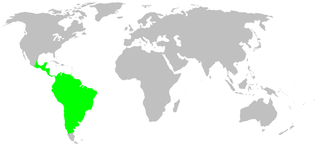
Misumena is a genus of crab spiders sometimes referred to as flower crab spiders. They are similar in appearance to several other genera in the family Thomisidae, such as Misumenoides and Mecaphesa.

The Goliath birdeater belongs to the tarantula family Theraphosidae. Found in northern South America, it is the largest spider in the world by mass – 175 g (6.2 oz) – and body length – up to 13 cm (5.1 in) – but it is second to the giant huntsman spider by leg span. It is also called the Goliath bird-eating spider; the practice of calling theraphosids "bird-eating" derives from an early 18th-century copper engraving by Maria Sibylla Merian that shows one eating a hummingbird. Despite the spider's name, it only rarely preys on birds.

The Guianas, sometimes called by the Spanish loan-word Guayanas, is a region in north-eastern South America which includes the following three territories:

The red-faced spider monkey also known as the Guiana spider monkey or red-faced black spider monkey, is a species of spider monkey found in the rain forests in northern South America.
Chinoscopus is a genus of jumping spiders that was first described by Eugène Louis Simon in 1901.
Eustiromastix is a genus of jumping spiders that was first described by Eugène Louis Simon in 1902.

Hypaeus is a genus of the spider family Salticidae.

Lyssomanes is a spider genus of the family Salticidae, ranging from South and Central America, up to the southern United States.

Noegus is a genus of jumping spiders that was first described by Eugène Louis Simon in 1900.

Pachomius is a genus of jumping spiders that was first described by George and Elizabeth Peckham in 1896. Uspachia was merged into genus Romitia in 2007, and all nine species were merged into Pachomius in 2015. The name is derived from Pachomius, the founder of cenobitic monasticism.
Pseudopartona is a genus of the jumping spiders only found in French Guiana. As of 2017, it contains only one species, Pseudopartona ornata.

Sarinda is a genus of ant mimicking jumping spiders that was first described by George and Elizabeth Peckham in 1892.

The Dendryphantina are a subtribe of jumping spiders that occur mainly in the New World. The subtribe was first defined by Anton Menge in 1879 as Dendryphantidae. Females of the subtribe generally show paired spots on the abdomen, and the males often have enlarged chelicerae. Females in this subtribe typically have S-shaped epigynal openings.

French Guiana is an overseas department/region and single territorial collectivity of France on the northern Atlantic coast of South America in the Guianas. It borders Brazil to the east and south and Suriname to the west. French Guiana is the only territory of the mainland Americas to have full integration in a European country.
Donald Benjamin Lurio, better known by his stage name of Don Lurio was an American-born Jewish Italian dancer, choreographer and presenter for RAI, the Italian national television.

Senoculus is a genus of araneomorph spiders in the family Senoculidae, and was first described by Władysław Taczanowski in 1872. It is the only genus in the family Senoculidae.

Ephebopus is a genus of northeastern South American tarantulas that was first described by Eugène Louis Simon in 1892. Its relation to other tarantulas is one of the most uncertain in the family, and it has been frequently moved around and has been placed in each of the eight subfamilies at least once.
Abapeba is a genus of Central and South American corinnid sac spiders first described by A. B. Bonaldo in 2000.
Micrepeira is a genus of orb-weaver spiders first described by E. Schenkel in 1953.
Pseudosparianthis is a genus of huntsman spiders that was first described by Eugène Louis Simon in 1887.
This page is based on this
Wikipedia article Text is available under the
CC BY-SA 4.0 license; additional terms may apply.
Images, videos and audio are available under their respective licenses.













